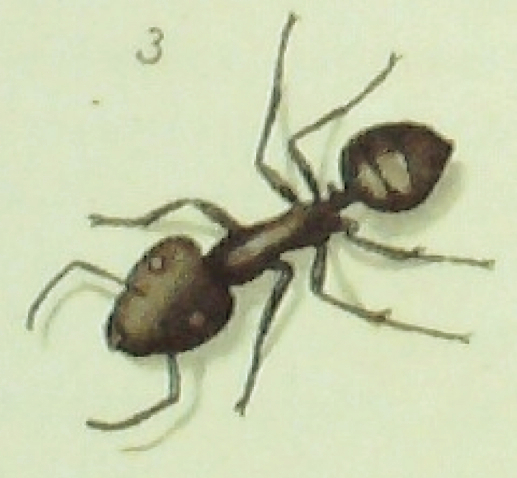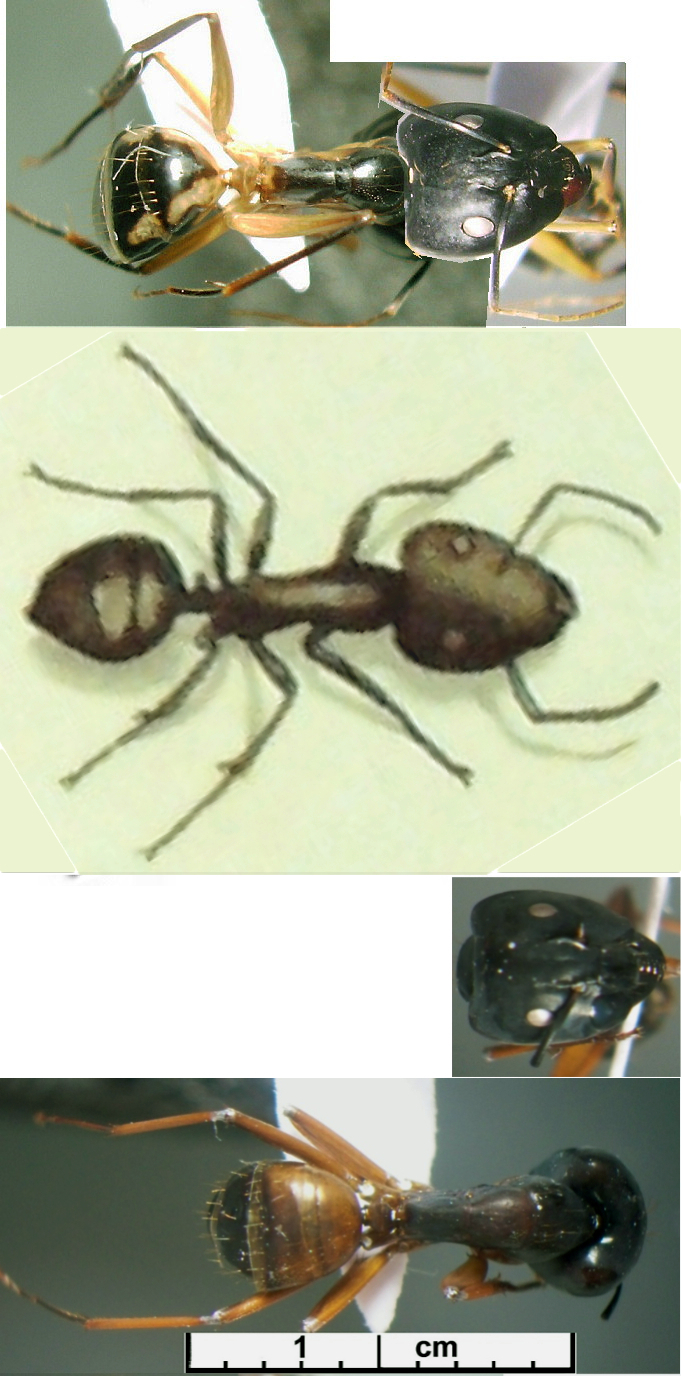Camponotus (Tanaemyrmex) rubripes (Latreille)
  Type location Sierra
Leone (Formica rubripes, Latreille, 1802c: 112, probably a
major), no images on Antweb (October 2014); major only described (see
Bolton, 1995) Type location Sierra
Leone (Formica rubripes, Latreille, 1802c: 112, probably a
major), no images on Antweb (October 2014); major only described (see
Bolton, 1995)  . .
|
 Latreille's (1802c) description is at Latreille's (1802c) description is at  . Brown with a black head and red-brown
legs; TL 20 mm; 9 lines (18.9 mm). Drury's (1770) illustrated note is
at . Brown with a black head and red-brown
legs; TL 20 mm; 9 lines (18.9 mm). Drury's (1770) illustrated note is
at  . Forel's (1886f: 147) note is at . Forel's (1886f: 147) note is at  . .
In Wheeler (1922) it was listed only as a synonym of maculatus
or vice-versa. Roger (1863b, No. 13; with a description
at 1863a: 133 - not in HNS pages) and Forel (1886f) had it as
a substantive species - "Esp. C. rubripes Drury (1770)"; the
latter naming it with various races (also given by him as stirps), e.g.
brutus, cognatus, maculatus and
solon.
Before the present revision and two new specimens from
Liberia (2013), I have to say that,
after struggling to comprehend Forel's (1886f) review of the confused
situation over rubripes, which he gave as the type species,
encompassing many races from all corners of the tropics to warm
temperate areas, I felt this needed to be consigned to the rank of
historical mystery and not taken as a meaningful and, hence,
identifiable species. To translate from Forel - "In brief C.
rubripes and its related forms are one of the most beautiful
examples in zoology which shows how the notions of species, race and
variety pass without boundary from one to the other".
Although Drury had judged it to be the same as the
Linneus Formica barbara (i.e Campontus barbarus),
Latreille remarked that was very different.
|
 What Latreille
described might seem most likely to be a
form of C. maculatus, in itself with such a list of so-called
subspecies and varieties as to be not far from nonsense, although the
type form does seem to be clearly identifiable as I have shown on the
species page - Camponotus
maculatus (Fabricius, 1782). The size range, colour, head shape
(almost triangular) and small eyes suggest other wise, possibly Camponotus
lycurgus which also comes from the right geographical area. What Latreille
described might seem most likely to be a
form of C. maculatus, in itself with such a list of so-called
subspecies and varieties as to be not far from nonsense, although the
type form does seem to be clearly identifiable as I have shown on the
species page - Camponotus
maculatus (Fabricius, 1782). The size range, colour, head shape
(almost triangular) and small eyes suggest other wise, possibly Camponotus
lycurgus which also comes from the right geographical area.
The illustration, however, is a montage of C.
maculatus
major from Benin (top) with a Drury's drawing centre and the fresh
major from Liberia (below). The
resemblance is quite remarkable, e.g. the HW and PW compare almost
exactly, as do the lengths of the scapes and funiculi.
|
Oxford University Museum
specimens
Camponotus (Tanaemyrmex) rubripes
B Taylor det.
|
Liberia
E Poirier
Yekepa Camp 4
SLAM 3
|
6.iv.2013
Nimba County
07°33’04" N
08°33’17" E
|
SLAM trap
Floodplain & marsh
501 m asl
major & minor
|
1
|
 |
Camponotus (Tanaemyrmex) rubripes
B Taylor det. |
Ivory Coast
Erena Dupont
iv.2014
|
Taļ National Park
5˚45'00" N
7˚07'00" W
|
05
minor
|
2
|
 |
Camponotus (Tanaemyrmex) rubripes
B Taylor det. |
Ivory Coast
Erena Dupont
v.2014
|
Taļ National Park
5˚45'00" N
7˚07'00" W
|
08
minor
|
2
|
 |
|
 The
photomontage of a major that appears to match the Drury note; from
Liberia, Yekepa;
collector E Poirier (Yekepa Camp 4 SLAM 3). Note the brown, smooth hind
tibiae. The
photomontage of a major that appears to match the Drury note; from
Liberia, Yekepa;
collector E Poirier (Yekepa Camp 4 SLAM 3). Note the brown, smooth hind
tibiae.
|
 The
photomontage of a minor worker from Liberia, Yekepa;
collector E Poirier (Yekepa Camp 4 SLAM 3). The
photomontage of a minor worker from Liberia, Yekepa;
collector E Poirier (Yekepa Camp 4 SLAM 3).
|
 The
photomontage of a minor worker from Ivory Coast, Tai; collector Erena Dupont (iv.2014, 08). The
photomontage of a minor worker from Ivory Coast, Tai; collector Erena Dupont (iv.2014, 08).
|
|